Meanwhile, fellow Bordeaux producer Château Carsin is experimenting with amphorae “to make a wine in the purest way possible”, as young winemaker Nea Berglund puts it. And, at Vignobles Ducourt, the first harvest of hybrid grapes Muscaris and Souvignier Gris has taken place.
These are just three examples of a distinct movement in the region towards easy-drinking, diverse, great value wines. Modern reds crafted to drink when young, but still with great ageing potential. Fruit-forward wines, made by shorter macerations, gentler extraction methods and less new oak and sulphur.
As in many regions, there is also a move towards wines made with minimal intervention in the vineyards and cellar, use of native yeasts and gravity-fed winemaking in order to deliver vegan-friendly wines with the truest expression of place.
Canopy talked to a few of the innovative winemakers about the new styles of Bordeaux wines and their different approaches.
Introducing ‘no-spray’ varieties
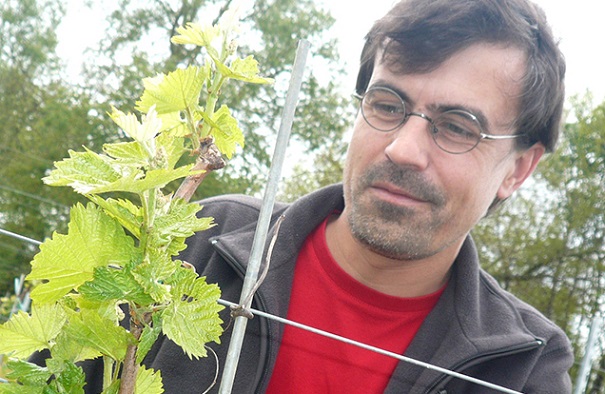
The historic family-run Vignobles Ducourt, which owns 450ha and 14 châteaux in six different AOCs, has planted four different disease-resistant varieties in the heart of Entre-Deux-Mers. The aims are to drastically reduce the amount of phytosanitary treatment in the vineyards, find out how these Swiss- and German-bred hybrids perform in Bordeaux’s oceanic climate and terroir, and prove there is a market for the resulting eco-friendly wines.
Ducourt’s oenologist, Jérémy Ducourt (above) – whose father, Philippe, is the vineyard manager – has released two varietal wines from two of the hybrids so far, and is vinifying the other two this vintage. Bottled as Vin de France and not as AOC wine, the current line-up comprises the Métissage white from the Sauvignon Blanc-ish Sauvignac (formerly Cal 604) and Métissage red from the Cabernet Sauvignon-ish Cabernet Jura. In the wings are wines from Muscaris and Souvignier Gris.
To explain more about the project, we contacted Ducourt’s sales and marketing manager, Jonathan Ducourt.
‘It is the best way to reduce pesticides’Canopy: Why did you plant red and white hybrid varieties in Bordeaux?
Jonathan Ducourt: “We are always looking at ways to reduce pesticides spray on our vineyards with better knowledge of the weather, better equipment for spraying, more work in the vineyard to reduce disease pressure, etc. When we discovered that some of the new hybrids were super-resistant and making good quality wines, we had to plant them and see for ourselves how it could work with Bordeaux’s oceanic weather.”
Has the experiment been successful?
JD: “Yes, beyond our expectations. We have reduced by 85% the number of times we spray the vineyard and we only use organic pesticides (copper and sulphur). We are now applying for organic certification for this vineyard.”
Is it a fun experiment or is there a commercial benefit?
JD: “Both. We wanted the project to be economically viable so, after a couple of years planting, we started to bottle and look for distributors for these new wines. It is typically a sommelier wine for those who want to go outside of the beaten path.”
Will you be increasing the plantings? If so, when?
JD: “Yes, after two plots were planted in 2014 (1.7ha of red and 1.3ha of white), we planted two more in 2016 and two more in 2018.
What’s the total hectarage now for each variety?
JD: “We have 13.5ha of hybrids varieties in Bordeaux:
- 4.1ha of Cabernet Jura (red hybrid from Switzerland);
- 3.5ha of Sauvignac (white hybrid from Switzerland);
- 3ha of Souvignier Gris (white hybrid from Germany)
- 3ha of Muscaris (white hybrid from Germany)
JD: “2016 was our first vintage. For now, we only have a red wine 100% Cabernet Jura and a white wine 100% Sauvignac.
What’s the latest production figure (in bottles) for each variety?
JD: “They are still young vineyards, small production. 20,000 bottles of red and 13,000 bottles of white. This year we are harvesting for the first time Muscaris and Souvignier Gris, so the production and maybe the range of wines will grow.”
'The Cabernet Jura taste is very different than your regular Bordeaux wines'Are you pleased with the resulting wines? And if so, why?
JD: “Very happy with the quality of Sauvignac grapes – they are fresh and aromatic, good acidity. They have a lot of potential. The Cabernet Jura taste is very different than your regular Bordeaux wines, it is very fruity and a deep colour while having no dry tannins and a light mouthfeel.”
Is it silly for people to talk about this as the future for Bordeaux?
JD: “It is one of the ways, for sure, not only for Bordeaux but many wine regions in the world where the weather conditions require pesticides use. It is the best way to reduce pesticides.
“Now the challenge is to find the good hybrid that will fit well to Bordeaux taste profile and reflect the terroir it is born from. It will take some decades and we need lots of growers to experiment so we can understand the potential of these new varieties.”
Tell us the pros and cons of these varieties.
JD: “Remember, with these varietals we start from a blank page, nobody has grown or vinified them in Bordeaux. We are still learning. Overall, we manage and vinify the same way we do for our Merlot or Sauvignon Blanc. They don't really have cons, except the fact that they are unknown varietals and hard to sell.”
The eco-couple
‘We are not looking for strong tannins, nor very powerful wines anymore’
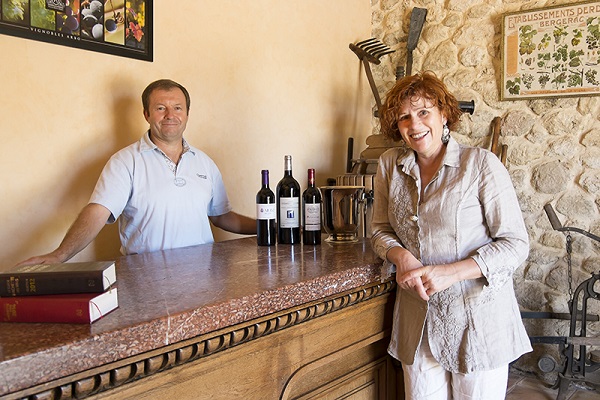
Bernadette and Joseph Arbo (above), owners of Vignobles Arbo, have been developing their estate since 1998. Today, they have more than 51ha under vine, divided into two appellations: Francs Côtes de Bordeaux and Castillon Côtes de Bordeaux. Their modus operandi is ‘respect the environment’: they have not used insecticides for more than a decade, have reduced their usage of sulphates by 50% and promote biodiversity by keeping hedgerows and allowing cover-crops in between the vines to encourage growth of bee populations. In winter, the vineyards are grazed by a flock of local sheep.
Producing some of the most intriguing reds in Bordeaux, Bernadette and Joseph Arbo have experimented with unoaked reds, modern winemaking techniques and ancient varietals, and boast a Malbec-dominant blend in their portfolio.
Canopy contacted Bernadette for further details.
‘For us, the oak is an asset and not a mask’
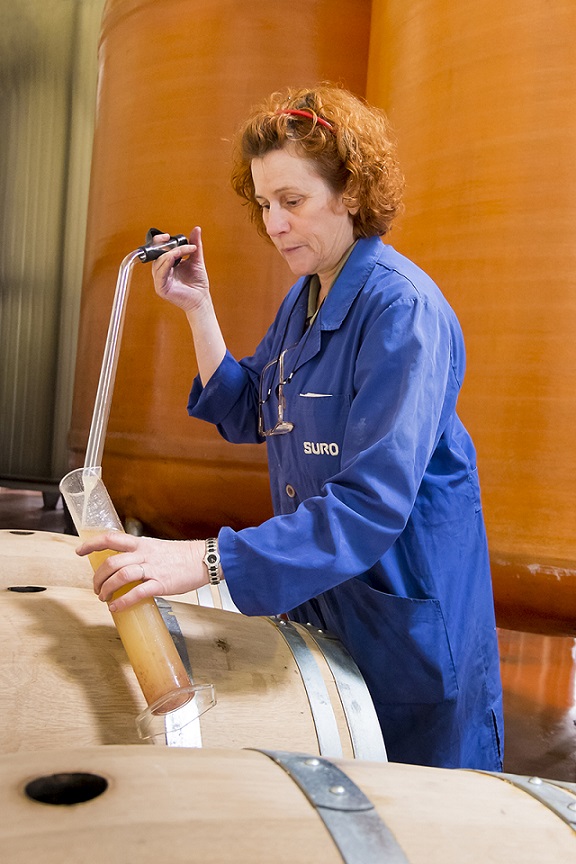
Canopy: Please tell us about your experiments with unoaked reds.
Bernadette Arbo (above): “We stopped using oak for one of our flagship cuvée to keep the freshness of the fruit. We would like to get the true expression of our terroir and the pure expression of the fruit. We, like our consumers, are more into ‘juicy’ wine, with freshness and great drinkability.
Does this mean you are turning your back on oak completely or are you just reducing it?
BA: “No, we still use oak for our red wines. We work a lot with our closest neighbours like Sylvain in Libourne, as we encourage local producers, especially when they are very good. We also work with some Burgundian coopers like Berthomieu, we like their style, very refined and pure.
“We are producing a beautiful cuvée – Chateau Godard Bellevue – with a great complexity and depth. It is a blend of old Merlot vines and Cabernet from our best terroir. This wine needs oak to round its tannins, to ‘polish’ them. According to the terroir and according to our cuvée personality, we use oak, but we never overuse it. We like the delicate toast that oak can bring to our wine, for us the oak is an asset and not a mask.”
What’s the best alternative to oak?
BA: “The best alternative we found is quite simple: cold maceration in stainless steel vats, in order to keep as much as we can the crispy, fresh fruit aromas. For our Malbec grapes, we start harvesting very early in the morning (before 5am usually), when it is cold outside (more or less 8°C), to preserve the fruit aromas and the spiciness of this varietal. Then, it is easier to start the natural cold pre-fermentation. It lasts usually three to five days.
'We had to find a way to produce wines which are ready to drink now'How does this change affect the structure, character and ageability of your wines?
BA: “Nowadays, we noticed that consumers want to enjoy the wine when they purchase it. Fewer people want to age the wine and wait for years before enjoying it. Consequently, we had to find a way to produce wines which are ready to drink now and able to age too, this is a real challenge! Fortunately, in Francs, we have great terroirs and our wines always had a nice complexity and freshness. Then, we are able to produce elegant wines, reducing the extraction, using soft methods to extract tannins during the winemaking process. Then, tannins are more delicate and silky, so we don’t need too much oak to polish them.”
Do you plan to do anything different for the 2020 vintage?
BA: “For 2020 vintage, indeed we have some plans and some new cuvée in mind. But we cannot reveal you everything now… we have to keep some secrets.
“More seriously, our winemaking techniques are the same for the 2020 vintage. Our driving goal is to respect the fruit and pick up the grapes at the perfect ripeness. Today, cold maceration seems to work well for us. But we are very openminded and always happy to discover new methods or technology. Our son, Dorian, is a great technical expert (BTS viticulture oenologique) and he helps us to improve our skill for four years now.”
What else is unusual in the way you do things?
BA: “Our winemaking techniques have the same purpose: respect the fruit as much as possible. We reduced pumping over, as it is stressful for the juice. The idea is to preserve the silkiness of the tannins. We are not looking for strong tannins, nor very powerful wines anymore. We are trying to keep the freshness, the crispiness and avoid the dryness. Our stainless-steel vats are thermoregulated and ensure perfect hygiene. During our winemaking process we use less and less sulphur (SO2). After the bottling process, on analysis, the SO2 quantity was extremely low, between 40 and 60g/L. We are not producing ‘natural wine’, but we get closer.”
'We are not producing natural wine, but we get closer'Tell me more about your Malbec and why it’s all done in stainless-steel tanks.
BA: “It seems natural for us to produce a (quite) 100% Malbec. Historically, Malbec has been produced in the Bordeaux region for decades and our limestone clay terroir is perfect to grow it. The first results were very interesting and positive. As our climate is not too warm, we preserved the freshness of the grapes. Our idea with this cuvée is to produce a daily wine for the consumer: easy to drink in its youngness, a lot of freshness with a eucalyptus note on the finish, a lot of crispy fruits (blackcurrant) and a touch of spiciness. Moreover, our winemaking in stainless-steel vat allowed us to preserve all these pure aromas. Our vats are neutral and never interfered in the taste of the wine.”
Is there anything else we should know about your winemaking or vineyards?
BA: “Today, a large part of our vineyard is more than 30 years old, which gives a strong identity and depth to our wines. For us, environment/vineyard respect is our priority, it is a driving factor. Since the year 2000, we have grown grass in all the rows of our vineyard. For the funny anecdote, we are good friends with the shepherd of our village and we encouraged him to bring his sheep flock to our vines to maintain and cut the grass. Then both parts are happy and we preserve our rows naturally.
“We developed a lot the biodiversity of our vineyard, by planting more and more hedges, fruits trees and natural borders. This biodiversity brings a lot of birds and bugs and together we fight against vines diseases.
“Today, we are very proud to be certified ISO14001 and HVE 3 (highest recognition in terms of environment protection).”
Using amphorae for “the best of both” oak and stainless steel
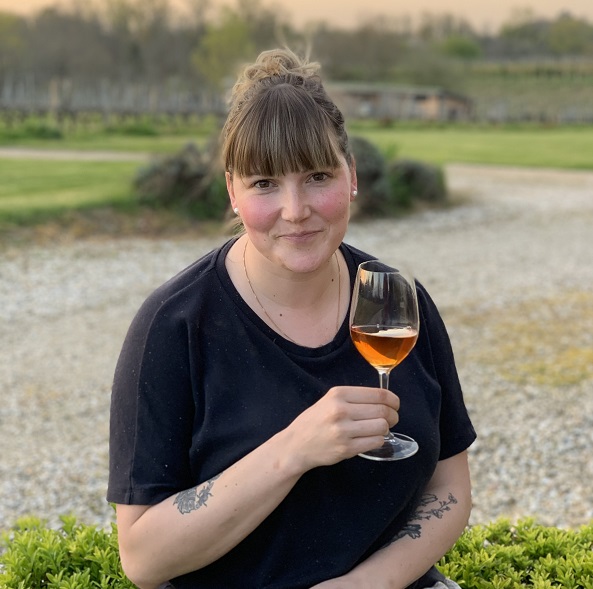
Château Carsin in Cadillac Côtes de Bordeaux has been owned by the Berglund family since 1990. Nea, daughter of owner Juha Berglund, took over the winemaking duties in 2015 and, since then, the focus both in the vineyard and cellars has been on minimal manipulation and intervention.
Nea (above) makes wine using natural fermentations and does not add any enzymes, tannins, acids or sugars to the wine, instead preferring wines that reflect the fruit of Château Carsin’s vineyards. In 2017, Nea started experimenting with clay amphorae as she is looking for more fruity and fresh reds.
She released her Amphora Carmenere, Amphora Cabernet Franc and Charivari L’Amour Fragile wines a few months after their bottling in the autumn of 2018.
'In 2017, I bought my first amphoras and the idea was to make a wine in the purest way possible'Canopy: Please tell us about your experiments with clay amphorae. What are these experiments, why did you start them, how have they turned out?
Nea Berglund: “I’ve always been an open-minded winemaker and I want the wines to reflect the fruit of our vineyards in the most authentic way possible. We work hard in the vineyards but, in the cellar, I prefer to do as little as possible. We don’t add acids, sugars or enzymes to our wines at all.
“In 2017, I bought my first amphoras and the idea was to make a wine in the purest way possible. I chose three parcels with three different grape varieties and I wanted to make those three wines in a way that the grapes would only be in touch with the amphora, not with barrels or stainless-steel tanks. The wonderful thing with barrels is the fact that they breathe, in other words, there’s micro-oxygenation that is provided by the barrels to the wine. The barrels, however, always give some taste to the wines like oakiness, as well as structure and tannins. Stainless steel is neutral and gives no taste to the wine, but it lacks porosity, so it’s not a breathing material. With the amphoras, I sort of thought I could get the best of both materials, as it’s neutral in terms of taste but also breaths.”
Are you moving away from oak or do you think it still has an important role to play in your wines?
NB: “For me, French wine barrels definitely play a big role and I don’t see myself moving away from using them. However, in the past 10 years, we have moved further away from using new oak and I prefer to use my barrels up to eight years. The older they get, the less oakiness they give to the wines, but they still help the wines to mature. When using older barrels, it’s easier to make wines with fresh and fruity style, just the way I like it. I’m not a big fan of big tannic wines that need dozens of years to age.”
What’s your winemaking philosophy in general?
NB: “At least 90% of our wines are made in the vineyards and my job as the winemaker is just not to mess it up! We work almost an entire year for creating the perfect ingredient, then we harvest it and after that I just need to cherish it in the cellar without adding any enzymes, sugars or acids to change its natural form. Our wines are authentic and pure. For me, the best possible outcome is when I’ve made a wine with minimal manipulation and it tastes great while reflecting our vineyards and different grape varieties.”
'I’m always afraid of breaking them, as they are quite fragile'Tell us the pros and cons of clay versus oak and stainless steel.
NB: “The amphoras are beautiful, but quite difficult to clean, that’s a con. I’m always also afraid of breaking them, as they are quite fragile. Stainless steel is a lot easier to clean and even for barrels we have designated cleaning devices. The amphora breaths more than a barrel and it can be a good thing, but also their porosity (just like barrels) can vary from one to another. So, they need to be tasted all the time and I need to keep an eye on them in case the porosity is not quite the same. It can have a different effect on the wine, whereas stainless steel is always the same. I guess that can be looked at in either a good or bad way, depending what you’re looking for.
“The wines made in barrels can age beautifully and I believe the amphora wines will too, though I only have experience of this from a few years. In the end, amphora is the oldest winemaking vessel! Not too long ago we had one of our red wines from the 90s which was still in a great condition. However, as the amphora wines have had more contact with oxygen, they might develop faster and will age quicker.”
Tell me more about how you use oak barrels, how it’s changed and what you are moving towards now regarding sourcing, sizes, number of fills, toasting etc…
NB: “I’ve been the winemaker at Chateau Carsin for five years now and, luckily, I have some great friends in the Bordeaux region. I buy my barrels from friends to be sure that they have been kept clean and well. I’m also lucky to have friends who have nice wineries! I always want to have a mix of cooperages, toasts and ages of barrels, the more diverse the better! Every year I try to buy some barrels of one or two years old, but usually I don’t buy any new barrels, that’s too much of the new oak taste for my wines.”
Do you plan to do anything different for the 2020 vintage?
NB: “Regarding the amphora wines, there are no different plans, we’re making our Carmenere, Cab Franc and Sauvignon Blanc. But the 2020 vintage will be different than any previous regarding the situation with the Covid-19. Normally we have 20 pickers every week but this year our seasonal workers are not all able to come and we’re going to have to manage with a small team. So far, things are going very well and we’re crossing fingers for good weather!”
Is there anything else we should know about your winemaking or vineyards?
NB: “I always want to underline that wine shouldn’t be so serious. I make several wines that are meant to be consumed with friends and that you can open on any day of the week; I call them ‘Monday wines’. For me, wine is something to enjoy and to share with family and friends. A Grand Cru Classé can be even better when combined with a good dinner and a ‘small wine’ can be better when shared in the right company.”
‘For me, wine is something to enjoy and to share with family and friends’


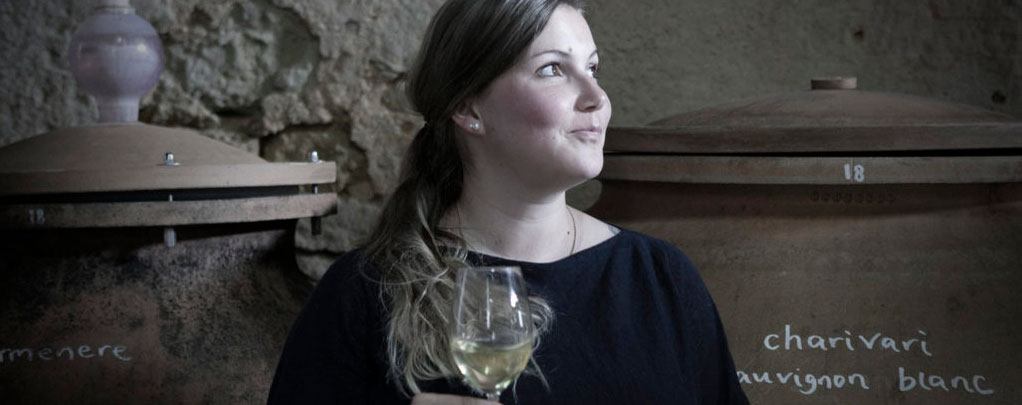










.png)






